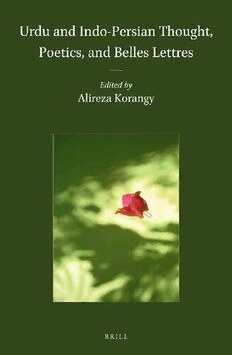
Urdu and Indo-Persian Thought, Poetics, and Belles Lettres PDF
Preview Urdu and Indo-Persian Thought, Poetics, and Belles Lettres
Urdu and Indo-Persian Thought, Poetics, and Belles Lettres Brill’s Indological Library Edited by Johannes Bronkhorst In co-operation with Richard Gombrich, Oskar von Hinüber, Katsumi Mimaki, Arvind Sharma VOLUME 51 The titles published in this series are listed at brill.com/bil Urdu and Indo-Persian Thought, Poetics, and Belles Lettres Edited by Alireza Korangy LEIDEN | BOSTON Cover illustration: Petal. With courtesy of FreeImages.com/Mario Alberto Magallanes Trejo. Typeface for the Latin, Greek, and Cyrillic scripts: “Brill”. See and download: brill.com/brill-typeface. isSn 0925-2916 isbn 978-90-04-25188-5 (hardback) isbn 978-90-04-34157-9 (e-book) Copyright 2017 by Koninklijke Brill NV, Leiden, The Netherlands. Koninklijke Brill NV incorporates the imprints Brill, Brill Hes & De Graaf, Brill Nijhoff, Brill Rodopi and Hotei Publishing. All rights reserved. No part of this publication may be reproduced, translated, stored in a retrieval system, or transmitted in any form or by any means, electronic, mechanical, photocopying, recording or otherwise, without prior written permission from the publisher. Authorization to photocopy items for internal or personal use is granted by Koninklijke Brill NV provided that the appropriate fees are paid directly to The Copyright Clearance Center, 222 Rosewood Drive, Suite 910, Danvers, MA 01923, USA. Fees are subject to change. This book is printed on acid-free paper and produced in a sustainable manner. To Shamsur Rahman Faruqi for his unparalleled scholarship in Urdu and Indo-Persian literary studies and an unselfish scholarly source for not only every contributor in this volume but hundreds more ⸪ Contents Introduction ix Acknowledgements xiv Part 1 Indo-Persian 1 K̲h̲ushgū’s Dream of Ḥāfiz̤: Authorship, Temporality, and Canonicity in Late Mughal India 3 Prashant Keshavmurthy 2 Notes on ʿAbdul Nabī Fak̲h̲rul Zamānī and Other Indo-Persian Storytellers of the Sixteenth and Seventeenth Centuries 23 Pasha M. Khan 3 Ḥāfiz̤ in the Poetry and Philosophy of Muḥammad Iqbāl 73 Natalia Prigarina Part 2 Urdu Literary Theory, Urdu Dāstān, Creative Writing, Urdu Philology 4 Revisiting that Earth(l)y, Glorious Tradition 87 Carla Petievich 5 Continuing the Tradition: A Commentary on the “Neglected” Verses of G̲h̲ālib 101 Mehr Afshan Farooqi 6 Voyeur Candle, Tattler Candle: The Semiotics of nāyikābheda in G̲h̲ālib’s Urdu Dīvān 39.1 117 Satayanarayana Hegde 7 Mīr as Suffering Curmudgeon: A Historical Hatchet Job 167 Frances Pritchett viii CONTENTS 8 “I am a Ruby Wrapped in a Rag”: Zay K̲h̲ay Sheen and the Possibility of Poetry as Autobiography 179 Gail Minault 9 “The Tide and Flow of Islam” Musaddas by Ḥālī as a Poetic Memorial of the Muslim Enlightenment in the Last Third of the Nineteenth Century 192 Ludmila Vasilyeva 10 Jūtē haiṉ jāpānī kaprē inglistānī: Sayyid Ross Masood’s Passage to Japan 217 David Lelyveld 11 From a Slave Garden into Cyberspace: Mirza Athar Baig’s Novels G̲h̲ulām Bāg̲h̲ and Ṣifr Se Ek Tak 229 Christina Oesterheld 12 A Translation of Shamsur Rahman Faruqi’s Prem Kumar Nazar 250 Baidar Bakht Index of Subjects 269 Index of Names 275 Introduction As introductions are merely occasions where a book’s aim is stated, I will be doing literally that here as anything else would make this a long-winded pre- face to themes that require much more discourse than allotted in an introduc- tion. The aim of this volume is to encourage more dialogue on Urdu poetics and Indo-Persian and facilitate a platform for further discussions that engage both of these wonderful studies comparatively—and without prejudice. This volume engages a few of the many themes Urdu poetics and Indo-Persian studies encapsulate. The complicated and often-enigmatic nuances of Urdu poetry and poetics have not received the attention they deserve in earnest. What is much worse: they are (specially Urdu poetry) sometimes dismissed as mere offshoots of works in Persian—and by extension Arabic (although less implied)—under the rubric of its close relationship with the two languages (specially Persian), and some of the individuals known to be responsible as influential figures in its fledglings as a literary force and more importantly a poetic phenomenon. Although Urdu literature stands on its own rhetori- cally and thematically there is no doubt, as any other literature, it has been influenced by an array of other productions—both thematically and linguis- tically diverse as is the case with most rich literatures in the world. As will be seen the essays herein present both a challenging channel for understan- ding Urdu’s modern and diverse literary production and its historical past; and bring to purview the importance of Indo-Persian not merely as a literary conti- nuum but indeed as a singularly rigorous genre of thought and hermeneutic to reckon with: one that demands more investigation. The contributions fall under two categories of (1) Indo-Persian; and (2) Urdu Literary Theory, Urdu Dāstān, Creative Writing, and Urdu Philology. Under the auspices of the first category, Prashant Keshavmurthy’s “K̲h̲ushgū’s Dream of Ḥāfiz̤: Authorship, Temporality, and Canonicity in Late Mughal India” reads “K̲h̲ushgū’s dream of Ḥāfiz̤ as a manifold response to three analytically dis- tinct needs that may be formulated in terms of the following questions: what were the social functions of K̲h̲ushgū’s memory of his vision of the poet he experienced at twelve years old? What relations did this dream vision bear to his multiply periodized temporality in the Safīnah of Persian literary history? And how were both these questions complicated in the question of his rela- tions with Sirājul Dīn ʿAlī K̲h̲ān “Ārzū” (d. 1756) and ʿAbdul Qādir K̲h̲ān “Bīdil” (d. 1720–21), his two most revered teachers and among the greatest Persian litterateurs of the age?” Interesting aspects of K̲h̲ushgū’s dream of Ḥāfiz̤ are employed by the author to answer the broader questions regarding K̲h̲ushgū’s
